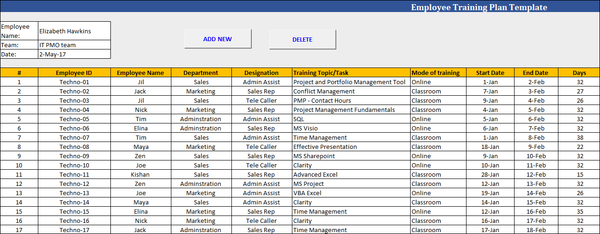Employee Training Plan
What Is Employee Training Plan?
Employee training and development refers to the process of providing employees with the skills and knowledge necessary to perform their jobs effectively. The goal of employee training and development programs is to help employees improve their work performance and contribute to the overall success of the organization.

Employee training and development programs can include a variety of different activities, such as classroom training, on-the-job training, e-learning, and job shadowing. The type of training and development program that is most effective for a particular organization will depend on several factors, such as the size of the organization, the nature of the work, and the budget.
If you are an employer, it is important to understand the different types of employee training and development programs that are available and to select the one that best meets the needs of your organization. Keep reading to learn more about employee training and development! There are a few different types of employee training and development programs. The most common type of employee training and development program is classroom training. This type of program takes place in a traditional classroom setting and typically includes lectures, discussions, and hands-on exercises.
Classroom training can be an effective way to provide employees with the skills and knowledge they need to be successful in their jobs. However, it is important to note that this type of program can be costly and time-consuming.
Another type of employee training and development program is on-the-job training. This type of program involves providing employees with the opportunity to learn new skills by performing the tasks they will be expected to do on the job.
On-the-job training can be an effective way to learn new skills, but it is important to make sure that employees are supervised while they are learning.
Why Employee Training Plan Is Important?
An employee training plan is a strategy that helps an organization achieve specific training objectives or goals. It is a formal document that outlines the who, what, where, when, and how of employee training. The plan is designed to help the organization meet its training goals systematically and efficiently.
The main purpose of an employee training plan is to ensure that all employees have the knowledge and skills necessary to perform their jobs at the highest level of competence. It is also a valuable tool for succession planning and career development.
An Employee Training Plan Can Also Help an Organization To:
- Reduce employee turnover
- Improve employee engagement
- Increase employee productivity
- Improve customer satisfaction - Enhance safety and compliance.
Training is an essential part of any organization because it helps employees be better equipped to do their jobs, and it also helps the organization to be more effective and efficient.
When done correctly, employee training can lead to several benefits for both the employee and the employer. For the employee, training can lead to improved job satisfaction, increased skills and knowledge, and higher productivity. For the employer, training can lead to reduced turnover, lower recruitment and training costs, and higher profitability.
Thus, it is evident that employee training is a key ingredient in the success of any organization. While there are many different types of training programs available, it is important to choose the right one for your organization's needs.
7 Steps To Create a successful Employee Training Plan

Employee training is essential for any organization that wants to maintain a competitive edge and ensure its employees can perform at their best. A good employee training plan will cover all the essential topics and create a learning environment that is conducive to employees’ needs.
The Following Are 7 Steps That You Can Take to Create a Successful Employee Training Plan:
- Define the goals and objectives of the training program.
- Conduct a needs analysis to determine what specific skills and knowledge employees need to acquire.
- Choose the most appropriate training delivery methods.
- Create training materials that are engaging and relevant.
- Train employees in small groups or individually, depending on their learning needs.
- Evaluate the effectiveness of the training program and make necessary adjustments.
- Follow up with employees after the training program to ensure they are putting their new skills and knowledge into practice.
Who Should Be Interested In Training and Development?
The field of training and development is concerned with improving the performance of employees in their jobs. It is a process that involves identifying the training needs of employees and providing them with the necessary skills and knowledge to perform their jobs.
There are several different types of training and development programs that organizations can offer to their employees. These programs can be either mandatory or voluntary, and they can be either technical or non-technical. Technical training programs focus on teaching employees the specific skills and knowledge required to perform their jobs, while non-technical training programs focus on teaching employees about the organization itself, its culture, and its values.
Organizations usually offer training and development programs to employees who are new to the organization or who are taking on new responsibilities. However, several other employees can benefit from these programs as well. For example, employees who are experiencing job dissatisfaction or who are struggling to perform their jobs effectively can benefit from training and development programs.
To decide which employees should be interested in training and development, organizations should first assess the needs of the business and what type of training would be beneficial. Training may be needed to improve employee productivity, reduce turnover, or update employees on new software or hardware. After the needs of the organization have been assessed, managers should then identify which employees would benefit most from the training and development opportunities.
List of Benefits of Employee Training and Development?
Employee training and development refers to the process of improving the skills, knowledge, and abilities of employees so that they can perform their jobs effectively. It is an important part of an organization's human resource management strategy.
There Are Many Benefits of Employee Training and Development. Some of the Most Important Benefits Are Listed Below:
1. Improved Employee Performance:
Employee training and development can lead to improved employee performance. Employees who are properly trained and developed can perform their jobs better and contribute more to the organization.
2. Increased Job Satisfaction and Motivation:
Employee training and development can also lead to increased job satisfaction and motivation. Employees who are properly trained and developed feel more satisfied with their jobs and are more likely to be motivated to do their best.
3. Enhanced Employee Morale:
Another benefit of employee training and development is enhanced employee morale. Employees who are properly trained and developed feel good about themselves and their jobs. This leads to increased employee morale which is beneficial for the organization.
4. Improved Employee Retention:
Employee training and development can also lead to improved employee motivation and retention. Employees who feel invested in by their company are more likely to stick around when opportunities arise elsewhere. This can be valuable to a company, which has already sunk the cost of hiring, on boarding, and developing those employees.
5. Less Chance of Peak Capacity Issues:
Employee training and development is a great way to plan for longer-term capacity needs. By preparing your employees ahead of time, you will be ready to handle any future growth or increased demand processes more efficiently.
6. Improved Safety:
Training helps managers know what potential safety concerns exist in parent/employee interaction areas as well as with equipment that parents might utilize during an event at your facility.




